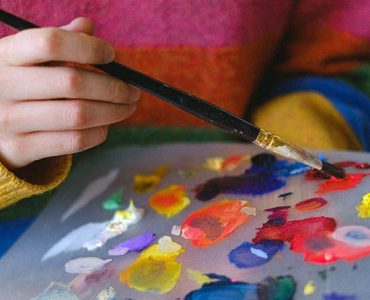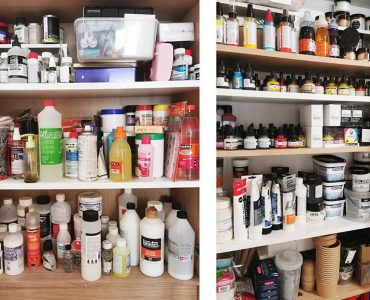
How To Complete The Back Of A Painting.
Are you an art student, a curator or a young artist, and are you unsure about the correct way to prepare the back of a painting? What indications should be present?
The art world is evolving and so are artists’ studios. More and more, it is up to the artist to ensure the quality of their artwork.
Here is a short list of 4 good things to remember When carefully completing a painting mounted on a stretcher for an exhibition or a shipment. Because a work of art needs to be pampered!
1/ A Safe Hanging System
A hanging system or a fixing kit is usually necessary to hang the work on the wall. When the elements are supplied in a bag or, better still, already placed on the back of the frame, it is a great comfort for the person receiving the work of art.
I recommend selling ready-to-hang artworks with the fixing system already installed to facilitate hanging, and thus offer a completely finished painting.
For a safe and inexpensive mounting kit, you can bring wire, wire cutters, 2 screw-in Ring Eyelets.
To avoid the fastening system sticking out of the back of the painting, and thus becoming a sharp point during packing or a pressure point during storage, I recommend that you screw inside the frame’s uprights. This is a 100% reliable technique that I have been using for years and which has always been approved by my gallery owners and clients.
The back of the painting remains flat and nothing sticks out. This fixing system does not risk damaging the package during shipment, nor the paintings stored next to each other, which means confidence is assured.

On the right, the screw-In Ring Eyelets is screwed in the frame so that it does not stick out.
2/ A Certificate of Authenticity
This part is more for the collector or for people who have just acquired a work of art and more specifically a painting.
The certificate should not be glued to the back of a painting, but stored in a safe place, in an archive box.
The certificate of authenticity is the work of art’s identity card. It is a document that is issued at the time of sale.
The certificate will follow the work of art throughout its life to enable it to be declared, identified and authenticated, but also to reassure the buyer in the event of a subsequent resale.
To be valid, the certificate of authenticity must contain several pieces of information but does not show any price, unlike the invoice (which is not a certificate by the way).
These products are currently available at GreatArt Online or in the art supply shop in London Shoreditch..

Store important documents in a safe place.
3/ A Caption to Inform
Many artists leave the back of a painting blank and generally forget that it will circulate without its creator and sometimes even without its certificate of authenticity.
In my experience, I have seen works abandoned in flea markets or in the storerooms of exhibition venues due to lack of information. In some cases, the artist’s signature does not even play its role as a name. Two initials on the front of the painting are not enough to easily find the artist.
To correctly write the caption for a work of art, recurring information should be added.
- Title of the artwork
- First name, surname of the artist (or artist’s pseudonym)
- Materials used (support, paint, etc)
- Year of creation (or a period if the work was created over several years)
- Place of creation (city, country)
Optional :
- Size (indicate if cm or inches)

I prefer to use thicker acrylic paint to mark up information. It has a much longer life and the colour remains stable over time, unlike marker ink which tends to yellow and fade with changes in ambient temperature.
GOOD TO KNOW: The term “mixed media” is used when the artist uses several techniques in the creative process. For paintings with multiple copies (silkscreen, print, etc.), indicate the number of prints and the number of each.
4/ A Guide to Making it Last
The label joins to the work of art, much like the one sewn into the collar of our clothes, is a very useful source of information for the new owner.
People who own a painting or sculpture are not always aware of the steps to take to ensure its proper conservation. It is therefore up to the artist to act as a guide and provide the necessary recommendations.
In order to ensure the quality and durability of the pigments, collages, varnish and support, I recommend that artists make a paper note with information on cleaning and storage. A label that can be placed on the back of the work.

As a general rule, the instructions for use label helps the collector to avoid the most common mistakes in everyday life.
For example: Do not use solvents or water, avoid sources of heat, humidity and direct sunlight.

Content provided by Amylee Paris
The passion of Amylee Paris, painter, consultant and author is to share her paintings between galleries, art collectors and her community. Beyond her pictorial skills and her several eBooks available online, Amylee is also recognized as one of the most influential francophone artist-entrepreneurs. She helps beginners or professional artists to optimize their artistic activity.
You can visit her colourful portfolio, follow her on Facebook and Instagram, or find all Amylee’s posts published in GreatArt online Magazineby clicking here!





















Add comment